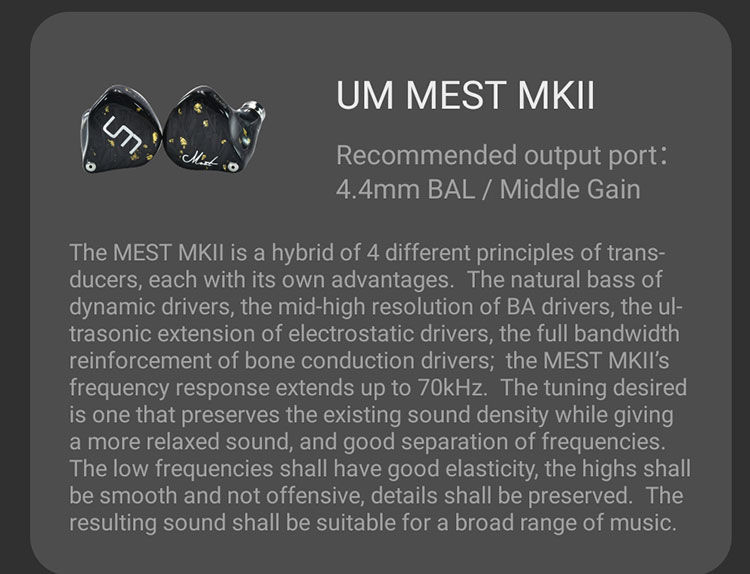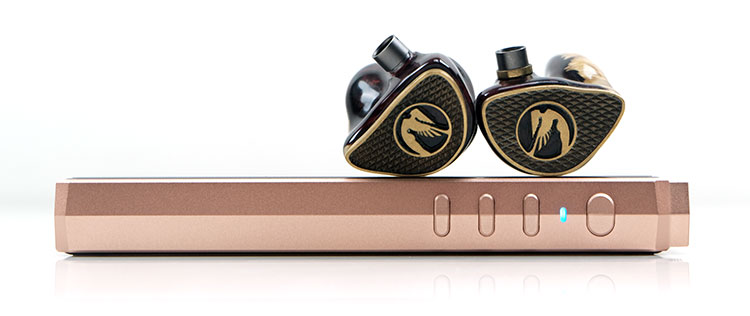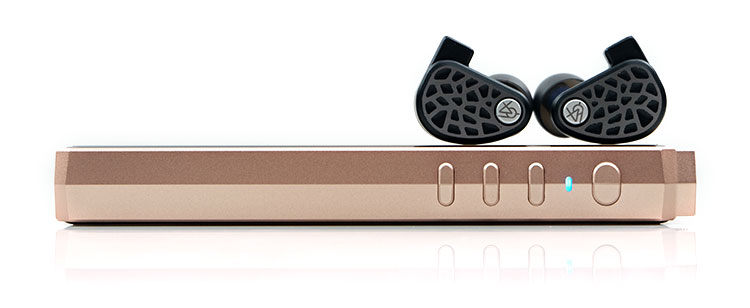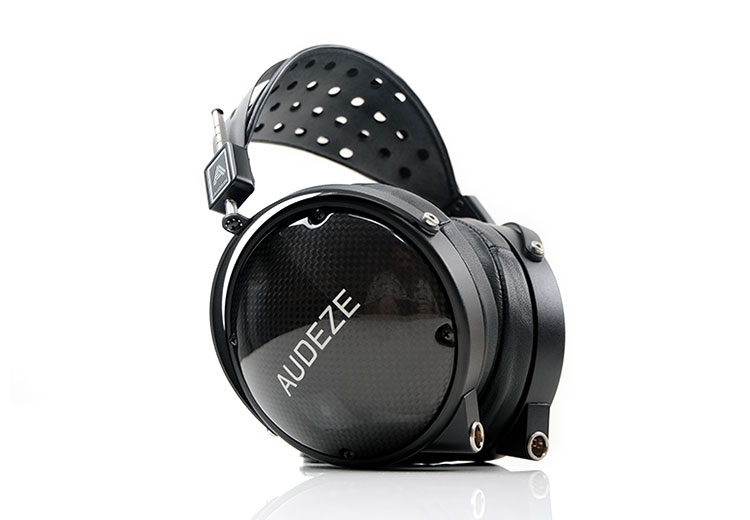Sound Impressions
The sound impressions were done with IEM users primarily in mind with the Empire Ears Odin, the JH Audio Jolene, and the VE Elysium as our pairings. For headphone users, you can read in more detail how the RS6 performed with the ‘big guns’ further down this page.
Coloration
If you have not guessed by now I am a fan of R2R DACs but it would be foolish to suggest every R2R implementation sounds the same. Such is the case with the RS6.
It still retains that core analog overtone that I would look for in R2R but the shaping and how they pair with IEMs is quite different from something like the R01 from Cayin, the R2R2000 from Hifiman, or the flagship LP P6 Pro‘s interpretation. That has to be a good thing for you the reader looking to make a judgment based on sound preferences.
Overall, the stock tuning of the RS6 delivers a warm smooth, and somewhat dense quality to its tuning that pairs extremely well with the likes of the VE Elysium and the Odin but less so with darker monitors. It has plenty of bass reach and teases out a fairly substantial heft that doesn’t really diminish too much until you hit the lower mids with our tested monitors.
For the most part, the RS6 synergy with IEM midrange tuning does not deviate too far from the bass coloration with a similarly smooth and rich response. Certainly, in comparison with the R01 from Cayin, it has a weightier midrange with less of an upper treble odd-harmonic lift so notes have a slightly more rounded and softer quality to its attack.
The instrumental texture is also broader, underpinned by an excellent bass fundamental and with a vocal quality erring slightly to the euphonic side. There is just enough treble presence, however, to keep it from sounding smoothed over.
I say the above in the context of the R2R2000 Red version whose bass presence has a lot more bloom punishing down the vocal and giving a much creamier almost veiled performance. You do not get that with the RS6 which has some excellent vocal presence with the likes of the Odin and especially with the Elysium’s mids dynamic driver.
Vocal Strengths
I actually prefer the vocal texture and tonal quality of the RS6 compared to the flagship R8. It may not be quite as articulate but the richer more inviting timbre plays very strongly to my preferences, especially with IEMs that place vocals on a platform such as the Odin and the Elysium.
That is one of the benefits of going with R2R for me, that difference between the grittier note quality compared to the articulate but polished tone of a good delta-sigma DAC.
You get a lot more character and physicality from vocalist performances using the NOS option with the RS6. Fans of Billie Eilish’s signature breathy vocal or Concha Buika’s raspy emotion-laden jazz-influenced flamenco fusion performances will lap up the RS6’s sumptuous and smooth reproduction of both.
Both singers are enhanced even more by a slightly forward emphasis to the RS6 midrange vocal imaging. The R8, with its AK4497 implementation, is not a bad vocal performer in its own right, but one that does not quite convey that same alluring vocal impact and forward imaging with a more digital feel to both artists’ voices despite the excellent resolution.
Staging
During the review process, the RS6 has my listening attention fixed more on the bass to midrange performance of my paired monitors. It is not a hugely expansive soundstage but, as discussed in our plugin section, it can be tweaked.
What the RS6 does well though is its staging weight with an excellent bass fundamental underpinning low-pitching percussion and bass plucks. Users with colored and overly bassy monitors might find it a bit too dense or warm but I actually found it far less dominating compared to the bloom of the R2R2000 Red for example. It is a fine balance though.
Compared to the R01 from Cayin the RS6 has a different type of staging emphasis in terms of depth. Despite offering a similar and impressive level of extension, I find the R01 offers a bit more bass to mids separation and slightly more focus on its sub-bass impact as a result. The RS6 low-end emphasis felt denser throughout and not quite as airy.
Mids emphasis is very good and if you are a mids or vocal fan then the RS6 pushes these to the fore very nicely with some decent width. Vocals sound ‘big’ with just enough odd-harmonic overtones to keep them clear sounding. Nothing worse than a muddy midrange which the RS6 successfully avoids.
The treble reach is good but overall, it is a bit more relaxed than bright or hugely airy sounding. Percussion has some good presence with a slightly rounded or smooth quality rather than an energetic high contrasting sound signature. This is more of a smooth treble tuning and entirely coherent with the mids and bass tonal quality.
Plug-In Magic
I hesitate to lump laid-back monitors in with dark IEMs for not pairing as well with the RS6 because the performance with the 64 Audio U18s was also excellent in terms of coloration. You can pull out an array of interesting DSP options from the RS6 to enhance potential synergy with pairings that might not be perfect with the stock sound.
For example, I was able to bring in some nice contrast and a bit more sparkle to the U18s and the Jolene with the MSEB Hot Monster plugin which gave both a bit of a boost in terms of overall dynamics and a cleaner attack, especially for the Jolene.
One other little tweak that I felt benefitted monitors such as the Jolene was the system-wide sound field plugin with a value of around 1.4. You can find this in the Audio settings section from the drop-down bar on the Android OS and that value is completely adjustable to your preference also.
This pushed out the staging dimensions to a fairly wide degree as well as an added bit of vibrancy and space to vocal performances on the Jolene. It sort of reminds me of a performance with a Crossfield filter turned off and the stock tuning has the Crossfield option turned on. A preference thing but one I personally liked with this monitor.
Synergy
Efficiency
Both the 4.4mm and 3.5mm output impedance ratings of the RS6 are sub-1Ω so those upgrading from the original R6 series should not have to worry about any impedance issues with low load sensitive BA driver IEMs.
The noise performance is also the best I have heard in a HiBy DAP to date with IEMs such as the Vision Ears VE8 and the Campfire Audio Solaris showing no signs of low volume background hiss or noise and no issues on channel balance due to the digital volume control implementation. And I include both 3.5mm SE and 4.4mm balanced PO in that statement.
Empire Ear Zeus uses will still get a fair degree of background hiss but I have yet to encounter any DAP that the Zeus won’t show up hiss on. It is one of those IEMs that simply does not synergy well with most amplifier stages in terms of noise performance. The closest I have got to a relatively quiet performance with the Zeus is paired to the DX300 MAX.
Power
The only way you should be running your headphones on the RS6 is via its 4.4mm balanced output. At 690mW into a 32Ω load, the power here is useful but not class-leading compared to the likes of the HiBy R8’s 1W Turbo mode. Going SE via its 3.5mm TRS output at 180mW into the same load will lose you some essential dynamic range and consequently a loss in soundstage complexity.
Meze Elite
For example, the Meze Elite actually does quite well with the RS6 in 4.4mm but loses its shape and definition sounding a bit more compressed and shallower via its weaker 3.5mm output.
I would suggest going high gain also with the Elite to ensure you get some good control on the volume since SE will push it very high. On balanced high gain, around 50 will get you to comfortable listening levels.
As for tonal synergy, the Elite is very easy on the ear with the RS6 but that’s a core strength of the Elite, to begin with. It is not a very hard planar headphone to drive anyhow but it will scale with more power so ranging against something like the R8 you will get a bit more dynamic range and tighter bass performances. However, the RS6 still impresses, especially for a smooth rich vocal.
Audeze LCD-XC
Another headphone pairing with a decent timbral pairing was the Audeze LCD-XC using the balanced 4.4mm output and staying on the RS6 NOS setting. I still think more power will give you a better performance in terms of dynamic and headroom but DAPs above 500mW will give a fairly engaging performance.
In terms of coloration, the thicker warmer tone and weighty low-end of the RS6 did well to offset the clean and brighter upper-mids of the stock XC tuning. Throw in some MSEB fine-tuning for bass extension and texture and you can get a fairly full and impactful presentation without too much upper-mids energy.
DCA Stealth
More demanding headphones such as the DCA Stealth came up a bit short. In terms of volume, the RS6 just about does it at 85 high gain but the bass lacks a bit of power and weight producing a shallower sound compared to something like the 2W capable Auris Audio HA-2SF desktop tube amp.
The timbral synergy is nice though for vocals, sounding clear, slightly forward, and fairly smooth but your ear is firmly fixed on that FR range since the bass lacks textural detail and sub-bass movement to deepen the soundstage which I know the Stealth can do given the right power.
Darwin Controller Presets
So far, HiBy has positioned the RS6 mainly as an IEM orientated DAP and that makes sense given the fairly light power rating on SE. Personally, I prefer going balanced with the RS6 for the superior instrumental separation and overall enhanced staging capability. The low noise factor going 4.4mm also makes this an IEM friendly option.
More than that, the Darwin Controller presets do bring a very interesting dimension, and whilst not as overt as MSEB or EQ tinkering, there were some subtle changes in how each IEM was presented once the preset in the 1.30G firmware edition was activated.
I won’t go through every preset in this review but below are a few samples of the changes noted with our tested monitors. One final note is that presets only work with NOS turned off which is understandable but personally, I prefer NOS turned on.

Vision Ears Elysium
Before we get into the gritty detail of this preset I have to say the Elysium was a wonderful pairing with the RS6 in NOS mode for vocal lovers.
You get some excellent texture and detail with both male and female vocals and very little in the way of harmonic dissonance or shrill highs from the stats drivers upsetting the overall balance. The bonus was the performance of the BA driver for the low-end which has some nice body and depth, aided along by the RS6’s meaty low-end tuning.
Based on that I was very hesitant to turn off the NOS mode, to be honest with you. Having said that, the Elysium probably was the most obvious of the three samples here in terms of changes to its performance from the preset.
Vision Ears have injected what seems to be a little more vibrancy in the midrange though with slightly less decay and a bit more precision in how the dynamic driver details are being presented.
With the stock tuning, I also hear a bit of bloom but the preset tightens that up with what seems to be a slightly shorter decay and a bit more odd-harmonic infusion which in turn improves the general instrumental separation and imaging.

Vision Ears VE8
The changes are subtle and more complex with the VE8 preset so you do have to go back and forth a bit to figure out exactly what they are doing because you can hear something initially on both the low-end and in the staging quality of the performance.
With the VE8 you get a little bit of a high-fidelity influence in the mids and highs. That means some shimmer on the very upper reaches and enhancing the staging width and presence beyond the upper mids. You get a sense that the space is filled in a bit more, particularly with left-right spatial cues that pick up a little sparkle and vibrancy.
The low end for me does not have a huge change, perhaps a tiny bit less mid-bass punch and more sub-bass volume but it is very subtle and it does feel very marginally relaxed but still very deep. Overall, it just sounds more complex to me and yes the layering does seem to stand out more after listening to this preset for a while.

Unique Melody MEST MKII
The presets here gave me an impression that UM just peeled back the physicality of the MEST MKII dynamic driver tuning a little to get that more relaxed sound they are aiming for in this description. Again, it is not huge, and took me a while to get to grips with what exactly I was hearing.
It doesn’t dramatically alter the overall tonal quality either. The timbre is exactly the same in that regard, rather the aggression or the weight of the punch of the dynamic driver response is down by a few dB.
And in doing so the mids and highs get a little bit more space to do their thing but unlike an MSEB swipe, it is not a radical change up top and is very subtle. I would say this is more to do with less bass forwardness than more mids and treble aggression since the harmonic controller even-harmonic weighting is lightly applied at a value of 32.
Click on page 2 below for more hardware features and software performance
Click on page 3 below for software features and wired/wireless performance
Click on page 4 below for sound impressions, Darwin presets, & pairings
Click on page 5 below for select comparisons





